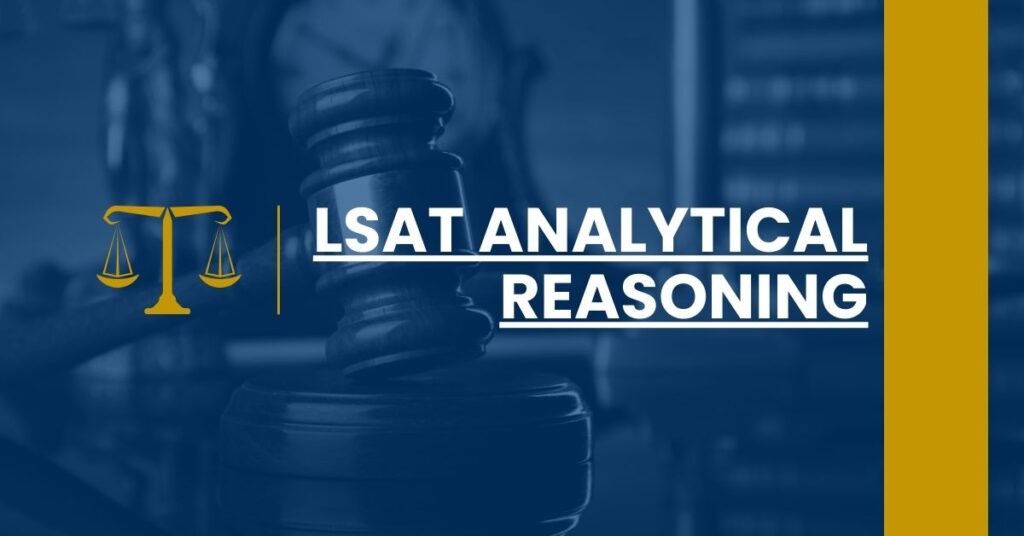LSAT Analytical Reasoning is the key to unlocking your law school potential.
- Mastering LSAT Analytical Reasoning: Discover strategies that streamline your problem-solving approach.
- Practicing LSAT Analytical Reasoning Questions: Find out how targeted drills can elevate your performance.
- Enhancing LSAT Analytical Reasoning Skills: Learn the skills that power top-tier LSAT scores.
Optimize your LSAT analytical reasoning prep today.
- Understanding the LSAT Analytical Reasoning Section
- The Structure of LSAT Analytical Reasoning Questions
- Logic Games Types: A Closer Look
- Question Types Within Logic Games
- Essential Strategies for Approaching Analytical Reasoning
- Practice Drills: Hone Your Analytical Skills
- Time Management Techniques for the Analytical Reasoning Section
- Study Materials and Resources for Analytical Reasoning
- Common Pitfalls and How to Avoid Them
- Preparing for Test Day: Last-Minute Tips
- Conclusion: Putting It All Together
Understanding the LSAT Analytical Reasoning Section
In the marathon of critical thinking that is the LSAT, one of the most challenging sprints is the Analytical Reasoning section. Intriguing yet demanding, LSAT analytical reasoning—often referred to as “logic games”—examines your capacity to understand, analyze, and draw conclusions from complex structures of formal, logic-based relationships.
What’s the Goal of This Section?
Here, you’re not just answering questions; you’re stepping into a world of patterns and sequences, unwrapping the underpinnings of logical constructs that are integral to the practice of law. The skills assessed are central to legal reasoning: think dissecting arguments, evaluating claims, and applying rules.
- What to Expect: You’re presented with an array of puzzles that require you to group, order, and correlate elements given certain conditions.
- The Setup: The section is made up of around 22-24 questions that you need to tackle within 35 minutes—yes, a stern test against time.
- The Big Picture: Not only does this section place a magnifying glass over your problem-solving acumen, but it also contributes significantly to your overall score. Mastering it is key to tipping the LSAT scales in your favor.
How Does It Fit the LSAT?
Your performance on LSAT analytical reasoning is a robust predictor of your first-year success in law school. It’s the terrain where your abstract thinking is pitted against reality’s rigidity. Hence, it’s crafted to be a litmus test for your prospective legal journey.
The Structure of LSAT Analytical Reasoning Questions
Once you delve into LSAT analytical reasoning, you’ll notice a structured pattern that demands a strategic approach. Every question is a tightly-woven tapestry of rules and variables which you are tasked to untangle.
Decoding Question Types
Most often, you’ll encounter scenarios where a set of conditions governs relationships among entities. You’ll need to employ deduction to ascertain:
- Basic sequencing of events or elements
- Group membership based on a cluster of criteria
- Matching attributes to fit a given framework
The questions might probe:
- Must be True/Must be False: Which outcomes are definitively determined by the conditions?
- Could be True/Could Happen: What are the possible, but not certain, scenarios?
- Most Strongly Supported: Which inference is best supported by the information provided?
A Tip on Approach: Start by broadly understanding the scenario then rapidly sifting through the rules to categorize and prioritize the information. It’s essential to break it down methodically—sort, interpret, then act.
Logic Games Types: A Closer Look
Venturing deeper into LSAT analytical reasoning, you’ll come across diverse “game” types, each with its peculiar quirks. Your adaptability to these types will be crucial.
Sequencing Games
Imagine a chain of events that must occur in a particular order—this is the essence of sequencing games. You might sequence items on a shelf or order events chronologically.
Grouping Games
Here, you’ll sort items into different groups, adhering to specific rules. Think of it as crafting a well-organized pantry where each ingredient has its designated space.
Matching Games
Under this umbrella, you’re matching characteristics or pairings, similar to solving who bought which car in various colors and models.
Anticipating game types helps you develop tailored strategies, thereby reducing the cognitive load during the actual test. For a deep dive into game specifics, the comprehensive guides provided by resources like 7Sage can be incredibly valuable.
Question Types Within Logic Games
Moving past game types, LSAT analytical reasoning introduces you to specific question types that accompany these games. Each question type requires nuanced tactics to navigate successfully.
Navigating The Mainstays
You will routinely encounter these varieties:
- Acceptability: Determining whether a given solution complies with all the rules
- Completion: Filling in the missing piece of a partially completed scenario
- Substitution: Identifying equivalent rules or conditions
Practice is your trusted ally here. Familiarizing yourself with common question types lays a solid foundation for confidence and speed—two indispensable allies in your LSAT toolbelt.
Essential Strategies for Approaching Analytical Reasoning
To truly excel in LSAT analytical reasoning, you must embrace robust strategies that play to your cognitive strengths while mitigating areas less familiar.
Diagramming is Your Best Friend
One indispensable tactic is diagramming—the art of turning confusing text into clear, visual relationships. Diagrams are not mere doodles; they’re the backbone of your analytical process.
- Sketch out Sequences: For sequencing games, linear diagrams with slots can efficiently illustrate order.
- Map out Groups: When it comes to grouping, establish clear boundaries and potential overlaps.
Employ Deductions Early and Often
- Elicit Direct Inferences: Grasp the immediate implications of the given rules.
- Combine Rules Creatively: Look for ways the rules interact to reveal deeper insights.
Focus on Order and Efficiency
Strategically prioritize games that cater to your strengths first while keeping a steady pace. It’s a balancing act between precision and speed. An extensive array of advice for honing your logical stamina can be found with expert coaches and resources on Shemmassian Consulting.
Remember, combating LSAT analytical reasoning is not about rote memorization. It’s about developing a flexible, analytical mindset that thrives under pressure. By embracing these strategies, your path towards LSAT—and legal—success will become clearer, one logic game at a time.
Practice Drills: Hone Your Analytical Skills
Practicing LSAT analytical reasoning doesn’t simply mean answering more questions—it’s about mindful repetition and the thoughtful analysis of every response. Here’s how you can sharpen your analytical acumen:
Identify Patterns Through Drills
- Spot the Familiar: Practicing different game types helps you identify patterns that, once recognized, can be approached with a tried-and-tested strategy.
- Vary Your Practice: Mix up the question types to prepare for the full range of puzzles you might encounter. This not only boosts your adaptability but also strengthens your ability to think on your feet.
Timed Situations Increase Game-Day Realism
- Simulate Exam Conditions: Regularly time your practice sessions to mirror the LSAT’s pressure. This habit helps condition your brain for the actual test environment and improves your pacing.
Reflect on Mistakes to Fortify Understanding
- Conduct Post-Game Analyses: After each practice session, spend time reviewing what you got wrong and why. Understanding your mistakes locks in learning and curbs the chance of repeating them.
By incorporating these drills into your study plan, you position yourself to master the sort of logical challenges that you’ll encounter when tackling LSAT analytical reasoning.
Time Management Techniques for the Analytical Reasoning Section
Achieving proficiency in LSAT analytical reasoning isn’t just about intellectual prowess—it’s equally about time management. Here are techniques to help you balance the scales:
Allocate Your Time Strategically
- Prioritize Approachable Games: Quickly scan and start with games that align with your strengths, ensuring an early confidence boost and the accumulation of quick points.
- Set Internal Checkpoints: Determine benchmarks for each game to keep yourself on track without having to frequently glance at the clock.
Develop a Rhythm to Build Speed
- Practice Consistently: Regular drills will gradually decrease the time you take per question, helping you build a natural momentum that carries through to the LSAT.
To manage your time more effectively, consider these insights into how seasoned LSAT takers allocate their minutes and approach each question.
Study Materials and Resources for Analytical Reasoning
Stellar resources can propel your LSAT analytical reasoning prowess from good to exceptional. Here are some materials to guide your expedition:
Harness the Power of Official Preptests
- Previous LSATs: Working through actual past LSAT exams offers the truest feel for the test and the analytical reasoning puzzles you’ll face.
Leverage In-Depth Guides and Courses
- Books and Courses: Specially designed LSAT prep books and interactive courses often provide comprehensive breakdowns of complex game types and nuanced question strategies.
By tapping into both traditional and contemporary study materials, you stand to gain a multifaceted, richer understanding of the LSAT analytical reasoning challenge that awaits.
Common Pitfalls and How to Avoid Them
Recognizing traps is as important as solving puzzles in LSAT analytical reasoning. Keep in mind:
Avoid Overlooking Rules
- Double-Check Constraints: Misinterpreting or overlooking a rule can lead to a domino effect of incorrect answers, so it’s imperative to read and interpret every rule correctly.
Sidestep Time Consuming Questions
- Know When to Move On: Getting stuck on a single tough question can be a significant time-drain; learn to recognize when it’s more strategic to skip and return if time permits.
By staying vigilant and understanding common missteps, you eliminate easily avoidable errors that can compromise your score.
Preparing for Test Day: Last-Minute Tips
Your final LSAT analytical reasoning preparation hinges on more than just studying; it’s also about ensuring your mind and body are primed for test day.
Condition Your Body and Mind
- Rest Well: A full night’s sleep before the test cannot be overstated. Rest is crucial for cognitive function—don’t compromise it.
- Nutrition is Key: Fuel your body with a balanced meal beforehand to maintain steady energy levels throughout the exam.
Mindset Matters
- Positive Visualization: Imagine yourself navigating the games with confidence. A positive mindset can significantly influence your performance.
Implement these last-minute preparation strategies and head into your LSAT with the assurance that you’re ready to face the analytical reasoning section head-on.
Conclusion: Putting It All Together
In wrapping up our comprehensive dive into LSAT analytical reasoning, remember that your journey to mastery is unique. From deeply understanding the structure of questions to regular drills and effective time management—all coalesce into a personalized strategy tailor-made for your success.
Arm yourself with quality resources, stay mindful of common pitfalls, and maintain a fortifying routine as the test day approaches. With dedication and smart preparation, you’ll be well-positioned to conquer the logic games and achieve a score that reflects your potential.
Every step forward, every practice question, and every moment spent honing your strategy brings you closer to not just LSAT success, but to the threshold of an exciting legal career. Now, harness these insights, embrace the challenge, and chart your course to LSAT excellence.

